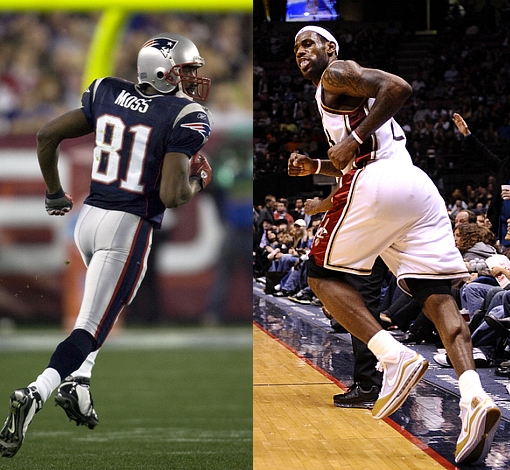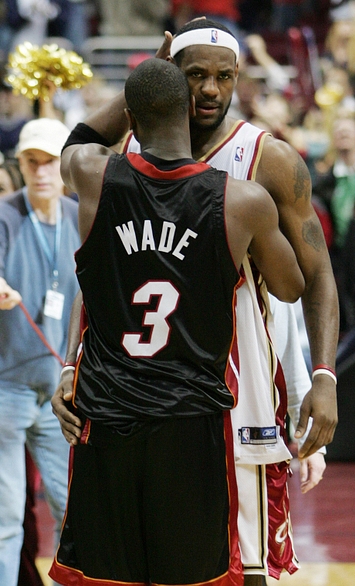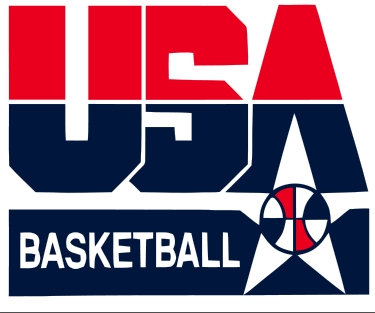5th October 2010
This is a quick hit-n-run/data dump post, but I was listening to Mike Pesca's trivia question on the Hang Up & Listen podcast, and I was curious about the NBA equivalent...
The question was: "Among NFL receivers with more than 12 TDs in a season, who has the biggest difference between their best seasonal TD total and their 2nd-best seasonal TD total?" The NFL answers are, according to the Hang Up Facebook page, Elroy Hirsch, Braylon Edwards (for now), and Patrick Jeffers.
My NBA equivalent would be: "Among NBA players with 10 Win Shares in a season, who has the biggest difference between their best season and their 2nd-best season?" The answer, after the jump...
Read the rest of this entry »
Posted in Analysis, History, Win Shares | 4 Comments »
27th September 2010
As part of Friday's post about the 2011 Heat's possible '07 Patriots connection, I had to run a little query splitting up every team's per-game point differential by each quarter of their season, and I thought we could make some use of that data today as well. To win 60+ games in today's NBA, a team needs to win 73% of its games, and that typically requires an average PPG differential of +7. This doesn't necessarily mean they played like a +7 team all season long, though -- if we break the season down into fourths (including playoffs), we find that only six teams in NBA history have ever played like a +7 team at every stage of the campaign:
| Year |
Team |
1stQ |
2ndQ |
3rdQ |
4thQ |
| 1971 |
Milwaukee Bucks |
11.67 |
14.83 |
15.08 |
8.75 |
| 1972 |
Los Angeles Lakers |
13.04 |
12.50 |
8.13 |
9.88 |
| 1972 |
Milwaukee Bucks |
13.43 |
11.74 |
9.61 |
7.75 |
| 1987 |
Los Angeles Lakers |
8.96 |
10.08 |
9.04 |
10.64 |
| 1991 |
Chicago Bulls |
8.21 |
7.16 |
13.08 |
9.68 |
| 1996 |
Chicago Bulls |
10.24 |
12.24 |
13.08 |
12.20 |
Even for a 60-win-caliber team, it's tough to maintain that level all season, especially given the fact that playoff games drag your 4th quarter differential down with their pesky increased opponent strength. Here's how the 60-win teams of recent vintage did it:
Read the rest of this entry »
Posted in Analysis, Data Dump, History | 7 Comments »
24th September 2010
 Sorry to go on a 2011 Miami Heat bender here, but BBR Blog reader Nick had an intriguing comment in response to yesterday's post about a possible weakness of the LeBron James/Dwyane Wade tandem:
Sorry to go on a 2011 Miami Heat bender here, but BBR Blog reader Nick had an intriguing comment in response to yesterday's post about a possible weakness of the LeBron James/Dwyane Wade tandem:
"Trying to compare the Heat to anything that has ever come before is an exercise in futility. You have the best player in the league, who happens to LOVE to pass teamed up with the second-or-third best player, who also is pretty fond of passing to the open man. They may both have had similar styles, but they ended up in those styles due to their teams' set-ups. How LeBron will act now that he can people to pass to who are good in their own right cannot be predicted with the information we have.
There's never been anything like it before. Every Heat game is going to be worth watching, especially against the crappy teams, because you don't know what sort of thing they'll bring out when they're way ahead. It wouldn't surprise me if they have regular season games where Miller shoots 20 3s and scores 30+ points, just because they think it'd be fun to do. This Heat team goes way beyond special into the realm of surreal."
That reminded me of a Chase Stuart post at PFR in October 2007:
Read the rest of this entry »
Posted in Analysis, Non-Basketball, Offseason, Season Preview | 22 Comments »
23rd September 2010
Last Friday, I posted about teams that formed as potent a slashing combo as the new LeBron James-Dwyane Wade duo in Miami, and found that in an incredibly small sample of similar cases (3, to be exact), at least one -- if not both -- of the players had to change their playing style to accommodate their new circumstance. A lot of people asked about the general effect of the new team member on the offense, though, so today I wanted to quickly follow up and look at whether the driving tendency of the added player correlated to the amount of offensive improvement the team saw.
Read the rest of this entry »
Posted in Analysis, History, Statgeekery | 11 Comments »
21st September 2010
When I posted last month about the all-time players who played for the best offensive and defensive teams in NBA history, there was a common theme among a number of the names at the top of each list: namely, they all played for a certain coach, or under a certain scheme. It only makes sense, then, to do the same study for coaches, and determine the guys who have called the shots for the top offenses and defenses of all time (or at least, since 1951).
Read the rest of this entry »
Posted in Analysis, Coaches, History, Statgeekery | 14 Comments »
17th September 2010
 One common observation about the new-look Miami Heat goes something like this:
One common observation about the new-look Miami Heat goes something like this:
- Dwyane Wade is a great perimeter player who makes his living attacking the basket. He's unstoppable when he drives into the lane, but not as good when you force him to shoot a jump shot.
- LeBron James is also a great perimeter player who makes his living attacking the basket. He, too, is unstoppable when he drives into the lane, but not as good when you force him to shoot a jump shot.
- Won't this redundancy in skills make the Heat easier to defend?
If only we could quantify this dilemma, find similar situations in the past where two hard-driving teammates joined forces, and see if their offenses were as potent as expected...
Oh, wait, we can.
Enter good old Free Throw Rate (FTA/FGA). Because the majority of fouls are assessed on interior shooting attempts and/or aggressive offensive plays, FTR is actually a pretty good indicator of where a player likes to operate from on offense. Players like Glen Rice and Dennis Scott were known for their low FTRs because they took a ton of perimeter jumpers, shots on which a foul would land you in the serious doghouse. And at the other end of the spectrum there's Reggie Evans, whose legendary FTRs tell the story of a player who rarely attempts a shot outside of point-blank range. Obviously there are some players who are exceptions to this rule, but the majority of players' inside-outside tendencies can be described simply by looking at FTA/FGA.
So that should be the starting point in examining the issue of hard-driving teammates. The next step is to compare everyone's FTR to some universal standard, and to do that I borrowed this method from PFR's Doug Drinen. I don't want to bore you with the details, but it basically compares everyone to the league average; 100 is average, numbers greater than 100 mean the player attacks the rim more than the average player, and numbers under 100 mean the player is less aggressive than the average player. The theory is that if we just look at these "FTR Index" numbers for perimeter players (PG, SG, SF), we can find players who drove to the basket the most, which best describes LeBron and D-Wade's playing style.
Read the rest of this entry »
Posted in Analysis, History, Season Preview, Statgeekery | 19 Comments »
13th September 2010
Team USA capped off a strong tournament yesterday by defeating host nation Turkey 81-64 in the championship game of the 2010 FIBA Worlds, and I'm going to cap off our coverage with the final U.S. advanced stats from the tourney:
Basic Stats
| Player |
G |
Min |
FG |
FGA |
3P |
3PA |
FT |
FTA |
ORB |
TRB |
AST |
STL |
BLK |
TOV |
PF |
PTS |
| Kevin Durant |
9 |
254 |
74 |
133 |
26 |
57 |
31 |
34 |
3 |
55 |
16 |
13 |
6 |
18 |
11 |
205 |
| Chauncey Billups |
9 |
208 |
25 |
64 |
14 |
44 |
24 |
28 |
2 |
17 |
28 |
11 |
0 |
9 |
22 |
88 |
| Derrick Rose |
9 |
207 |
27 |
59 |
5 |
18 |
6 |
12 |
3 |
19 |
29 |
11 |
3 |
14 |
12 |
65 |
| Lamar Odom |
9 |
198 |
28 |
52 |
3 |
4 |
5 |
10 |
24 |
69 |
4 |
5 |
6 |
9 |
22 |
64 |
| Russell Westbrook |
9 |
175 |
29 |
62 |
3 |
7 |
21 |
25 |
14 |
25 |
23 |
12 |
4 |
16 |
12 |
82 |
| Andre Iguodala |
9 |
170 |
20 |
34 |
2 |
7 |
9 |
19 |
18 |
41 |
17 |
16 |
0 |
13 |
21 |
51 |
| Eric Gordon |
9 |
158 |
27 |
59 |
19 |
42 |
4 |
5 |
1 |
14 |
5 |
8 |
2 |
6 |
14 |
77 |
| Rudy Gay |
9 |
121 |
22 |
45 |
6 |
19 |
13 |
18 |
9 |
26 |
7 |
9 |
8 |
4 |
16 |
63 |
| Stephen Curry |
8 |
85 |
14 |
31 |
7 |
19 |
2 |
2 |
3 |
11 |
17 |
4 |
0 |
8 |
11 |
37 |
| Kevin Love |
9 |
80 |
20 |
35 |
4 |
9 |
7 |
9 |
16 |
44 |
7 |
3 |
1 |
7 |
8 |
51 |
| Tyson Chandler |
9 |
76 |
9 |
14 |
0 |
0 |
5 |
10 |
12 |
24 |
4 |
2 |
5 |
2 |
16 |
23 |
| Danny Granger |
7 |
68 |
12 |
30 |
3 |
13 |
2 |
4 |
2 |
6 |
7 |
1 |
1 |
1 |
6 |
29 |
| USA |
9 |
1800 |
307 |
618 |
92 |
239 |
129 |
176 |
117 |
375 |
164 |
95 |
36 |
108 |
171 |
835 |
| Opponents |
9 |
1800 |
217 |
569 |
66 |
219 |
114 |
173 |
111 |
324 |
101 |
53 |
18 |
146 |
172 |
614 |
Read the rest of this entry »
Posted in Analysis, History, International Basketball, Statgeekery | 12 Comments »
7th September 2010
Several times in the past, I've looked at what I called "Team Continuity" -- that is, the amount of minutes/possessions/etc. that a team gave to players who had been on their roster the year before. Today, I want to extend the concept to the NBA as a whole and examine league continuity, specifically the 5-year periods since the merger in which the league had the biggest influx of new talent.
Read the rest of this entry »
Posted in Analysis, History, Statgeekery | 6 Comments »
2nd September 2010
In sports, expectations can be a funny thing. While in the end no amount of losing is truly tolerated, some coaches can get away with sub-.500 seasons while others can be fired despite a reasonable amount of success, all because of front office expectations for the team. Take a football example -- Marty Schottenheimer, for instance. Schottenheimer was fired by the Browns in 1989 despite a 40-23 record (with 4 playoff appearances) in the previous 4 seasons, simply because Cleveland could never quite get over the hump in the postseason. Fast-forward 18 years, and Schottenheimer was canned by the Chargers for the very same reason, despite 3 straight winning seasons and a 14-2 record in 2006. In each case, the team was no more successful under Schottenheimer's replacement (perhaps revealing that management's expectations were too high in the first place), but that's of little consolation to the unemployed coach who, for the most part, did his job well.
So with this phenomenon in mind, here are ten NBA coaches for whom winning simply wasn't enough -- namely, the top 10 W-L seasons by coaches who were fired the following offseason:
Read the rest of this entry »
Posted in Analysis, History | 3 Comments »
31st August 2010
 In case you've been as interested as I have in the international basketball action over the past few weeks, I thought I'd post some advanced stats for Team USA (including exhibitions + group games so far). Also, my apologies to our non-American readers for this all-Red-White-and-Blue edition; I would include other teams, but I can't find a statsheet-style printout of their data online, particularly for the pre-tournament warmup games. Perhaps the USA Basketball site will eventually post every team's numbers, though, like they did for the Olympics.
In case you've been as interested as I have in the international basketball action over the past few weeks, I thought I'd post some advanced stats for Team USA (including exhibitions + group games so far). Also, my apologies to our non-American readers for this all-Red-White-and-Blue edition; I would include other teams, but I can't find a statsheet-style printout of their data online, particularly for the pre-tournament warmup games. Perhaps the USA Basketball site will eventually post every team's numbers, though, like they did for the Olympics.
At any rate, here are the results & numbers for the team so far (feel free to compare to the Redeem Team's stats):
Read the rest of this entry »
Posted in Analysis, International Basketball, Statgeekery | 8 Comments »

 Sorry to go on a 2011 Miami Heat bender here, but BBR Blog reader Nick had
Sorry to go on a 2011 Miami Heat bender here, but BBR Blog reader Nick had  One common observation about the new-look Miami Heat goes something like this:
One common observation about the new-look Miami Heat goes something like this: In case you've been as interested as I have in the international basketball action over the past few weeks, I thought I'd post some advanced stats for Team USA (including exhibitions + group games so far). Also, my apologies to our non-American readers for this all-Red-White-and-Blue edition; I would include other teams, but I can't find a
In case you've been as interested as I have in the international basketball action over the past few weeks, I thought I'd post some advanced stats for Team USA (including exhibitions + group games so far). Also, my apologies to our non-American readers for this all-Red-White-and-Blue edition; I would include other teams, but I can't find a